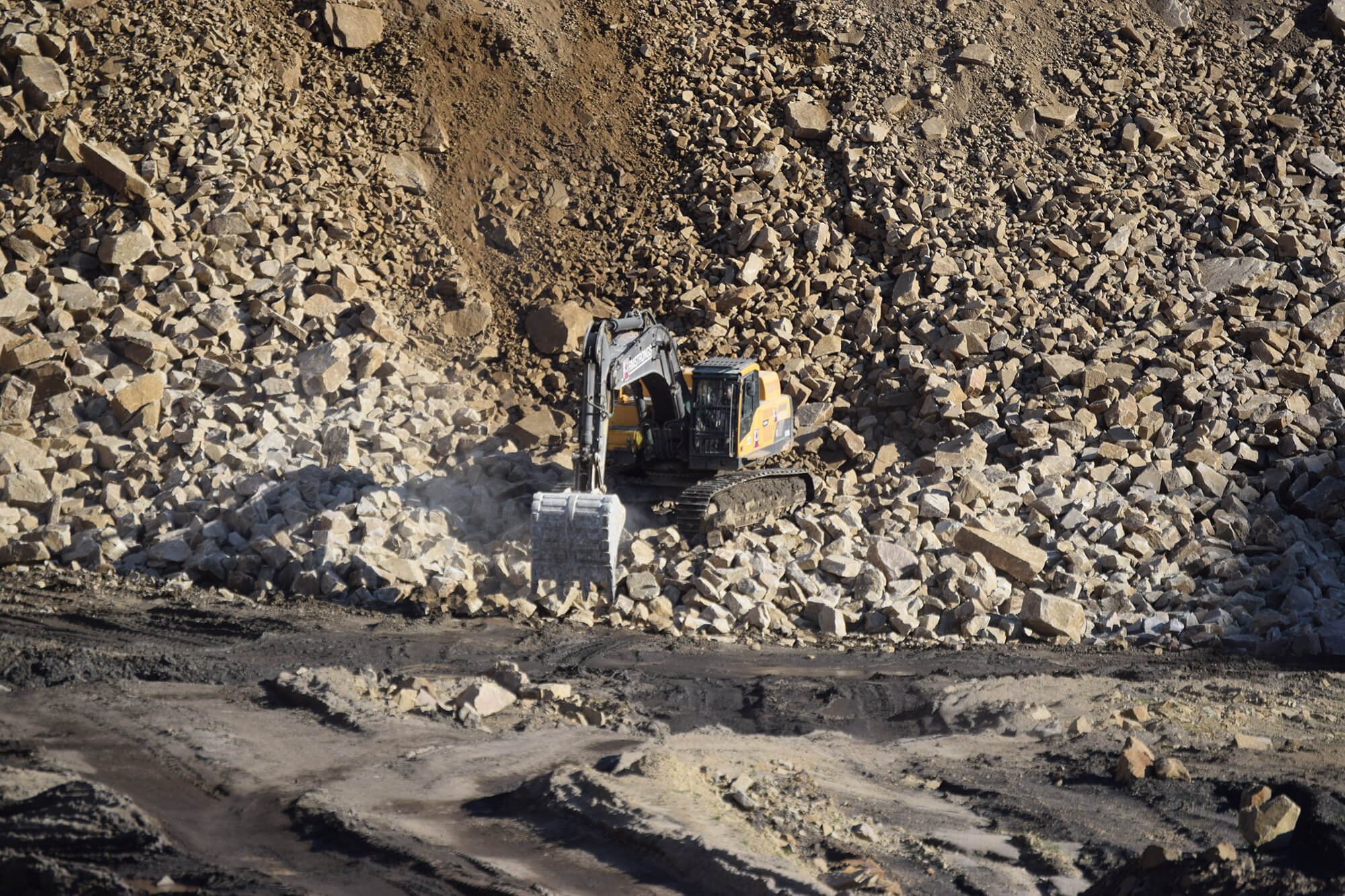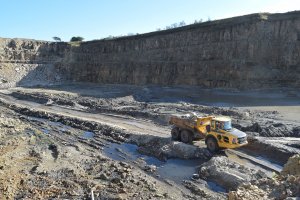The Benefits of Gritstone in Infrastructure and Heavy-Duty Applications

At Armstrongs, we’ve spent years refining our expertise in quarrying and providing high-quality gritstone for various industries.
Our Montcliffe Quarry, located near Horwich in Greater Manchester, has been operational for over a century and is known for producing some of the most resilient gritstone in the region.
This well-cemented sandstone offers exceptional strength and durability, making it an invaluable material for infrastructure and heavy-duty applications.
Gritstone’s unique composition, alongside our commitment to quality, allows us to support projects that require both structural reliability and longevity.

What is Gritstone?
Gritstone is a robust type of sandstone that has been naturally cemented over time to form a dense, grainy texture. Often mistaken for other types of sedimentary rock, gritstone is unique in its composition, which primarily includes quartz and feldspar.
This mineral mix, combined with gritstone’s natural cementation, gives it high compressive strength and resistance to wear, making it especially suitable for construction and infrastructure.
Gritstone’s formation occurs over millions of years, with sediment accumulating, compressing, and eventually forming the tough stone we quarry today.
At Armstrongs, we are proud to source some of the highest quality gritstone from our Montcliffe Quarry, a trusted source for construction-grade material that meets rigorous industry standards.
Properties of Gritstone
Gritstone’s physical properties set it apart from many other building materials. Its high density and grainy structure contribute to a strength that holds up under heavy loads and extreme weather conditions.
Unlike softer sandstones, gritstone is incredibly resistant to weathering, meaning it stands the test of time in both exposed and high-stress environments. This durability is one reason it’s chosen for demanding applications, from road bases and railways to foundations and retaining walls.
Another advantage of gritstone is its low porosity, which enhances its resistance to water penetration, reducing the risk of freeze-thaw damage—a common issue in temperate climates like the UK.
Gritstone’s unique properties not only provide structural benefits but also offer a natural aesthetic that blends well into both urban and rural landscapes, making it a versatile option for projects that balance form with function.
Armstrongs’ Gritstone from Montcliffe Quarry
A Century of Quality Production at Montcliffe Quarry
Montcliffe Quarry has been an essential part of Armstrongs’ operations for over a century, supplying top-quality gritstone to support infrastructure and construction across the UK.
Located near Horwich, Montcliffe Quarry is known for its well-cemented sandstone—referred to as gritstone—which is distinguished by its durability and strength. The quarrying process at Montcliffe follows traditional methods, with Armstrongs employing tried-and-true techniques such as blasting, crushing, and screening.
This hands-on approach, combined with Armstrongs’ commitment to modern safety standards and precision, ensures that every block of gritstone extracted meets the exacting quality required for heavy-duty applications.
Our gritstone has consistently proven to be a reliable building material, trusted for use in a wide range of projects.
High-Quality Aggregate Production
At Armstrongs, we understand that quality is paramount for every construction and infrastructure project. Our gritstone undergoes a meticulous production process to ensure it meets industry standards for strength, durability, and consistency.
After extraction, gritstone blocks are crushed and screened to create aggregates of specific sizes and grades, suitable for diverse applications.
Each step of the process is carefully managed to maintain high standards, with quality control checks in place to ensure the final product meets the stringent requirements for infrastructure use.
Our gritstone aggregates from Montcliffe Quarry are renowned for their dependability, providing a stable foundation for projects ranging from road bases to structural supports.
Key Benefits of Gritstone in Infrastructure
Exceptional Strength and Durability
One of the defining characteristics of gritstone is its exceptional strength. This dense, well-cemented sandstone is naturally suited to heavy-duty applications, standing up to significant loads and withstanding both physical and environmental stressors.
The unique mineral composition of gritstone, including quartz and feldspar, enhances its hardness, making it resistant to wear from constant pressure and heavy traffic. It also shows excellent resilience against weather extremes, whether in coastal areas or exposed inland settings.
This strength allows gritstone to perform reliably in infrastructure projects where durability is critical, from road construction to large retaining walls.
Versatility in Various Applications
Gritstone’s adaptability makes it an asset in a variety of construction projects, suited to both structural and decorative purposes. It has been used for foundational elements like load-bearing walls, retaining walls, and bridge supports, where its density and strength are invaluable.
Gritstone’s natural grainy texture and colour variations also lend themselves to architectural features, adding both functionality and aesthetic appeal.
At Armstrongs, our gritstone has been chosen for projects requiring robust materials that can blend seamlessly with natural and built environments alike, underscoring its versatility in infrastructure and design.
Low Maintenance and Longevity
Gritstone’s resilience and natural resistance to wear make it a low-maintenance choice for infrastructure. Its weatherproofing properties mean that, even with prolonged exposure to the elements, gritstone requires minimal upkeep.
This reliability translates into long-term cost savings for projects, as structures built with gritstone experience less wear and require fewer repairs over time.
Its resistance to erosion and decay contributes to a lengthy service life, making gritstone not only a cost-effective solution but also an environmentally responsible one, as it reduces the need for frequent replacements and resource consumption.
Heavy-Duty Applications of Gritstone
Gritstone in Road and Railway Construction
Gritstone is an exceptional material for road and railway construction due to its strength, durability, and resistance to wear. When used as a sub-base, gritstone offers unparalleled stability, ensuring roads and railways can withstand continuous, heavy loads and the stress of high-traffic areas.
Its dense structure helps prevent subsidence, reducing the risk of surface cracks and deformities over time.
The strength of gritstone aggregate makes it a preferred choice in areas that require reliable, long-lasting support, providing the foundation for safe and durable transportation networks.
Structural and Foundation Uses
In construction, gritstone’s load-bearing capabilities are highly valued, particularly for foundations, bridges, and retaining walls. Its inherent strength supports complex engineering projects where stability is critical, ensuring structures maintain their integrity under heavy weight and pressure.
Gritstone’s ability to handle substantial loads makes it ideal for foundations, providing the secure footing necessary for multi-story buildings and infrastructure projects.
At Armstrongs, we understand that gritstone’s reliability is essential in supporting large-scale structures, making it a prime material choice for developers and engineers.
Gritstone for Coastal and Riverbank Defences
Gritstone also plays a critical role in coastal and riverbank defence projects. As a durable and weather-resistant material, it is frequently used in rip rap and other defensive structures designed to protect shorelines from erosion.
When strategically placed, gritstone effectively absorbs and deflects wave energy, helping to safeguard coastal infrastructure. It has proven to be highly effective in reducing erosion and preserving the integrity of riverbanks, providing a natural yet robust barrier against the forces of water.
Armstrongs’ gritstone is trusted in projects where longevity and resilience are paramount, particularly in areas prone to harsh weather conditions.
Environmental and Sustainable Benefits of Gritstone
Natural and Locally Sourced Material
Sourcing gritstone locally, as we do at Armstrongs’ Montcliffe Quarry, offers significant environmental benefits by reducing the carbon footprint associated with long-distance transportation.
Using a locally sourced, natural material like gritstone supports sustainable building practices, minimising the environmental impact of construction projects.
By choosing gritstone from Armstrongs, clients contribute to eco-friendly construction that prioritises the health of our planet without compromising on quality or durability.
Gritstone’s Role in Sustainable Construction
Gritstone’s exceptional durability contributes to sustainable construction by extending the lifespan of the structures it supports. Its long-lasting properties mean fewer replacements, less frequent maintenance, and a reduction in the need for additional resources.
At Armstrongs, we are committed to responsible quarrying practices at Montcliffe Quarry, ensuring that gritstone is extracted with minimal environmental impact.
By offering a product that balances strength, longevity, and sustainability, Armstrongs supports the construction of infrastructure that meets the demands of today while considering the needs of future generations.
Choosing Gritstone for Infrastructure Projects
When selecting materials for infrastructure projects, gritstone stands out due to its unique combination of strength, durability, and cost-effectiveness.
Compared to other aggregates like limestone and granite, gritstone offers exceptional resilience in high-stress environments, particularly in heavy-duty applications such as road and railway construction, foundations, and retaining walls. While granite is also strong and often used for structural work, it can be more costly than gritstone.
Limestone, although versatile, doesn’t quite match gritstone’s durability for projects requiring long-lasting solutions under heavy load. Gritstone provides an ideal balance of cost and performance, making it a preferred choice for clients seeking a reliable, affordable solution for robust infrastructure.
Armstrongs’ Expertise in Supplying Gritstone
Armstrongs has established itself as a leading supplier of high-quality gritstone, sourced directly from our Montcliffe Quarry. With over a century of operational expertise, we understand the unique requirements of infrastructure projects and are equipped to meet the large-scale demands of the construction industry.
Our focus on quality and consistency ensures that the gritstone we provide is tailored to suit a variety of applications, from road construction to coastal defence.
Armstrongs’ gritstone is processed and screened to meet specific industry standards, making it a trusted choice for contractors, developers, and civil engineers across the UK.
Gritstone FAQs
What is gritstone, and how is it used in construction?
Gritstone is a well-cemented sandstone known for its strength and durability, making it highly suitable for heavy-duty construction applications.
Its resistance to weathering and high load capacity make it ideal for foundations, road bases, railway ballast, and coastal defences.
Why is gritstone a preferred material for heavy-duty applications?
Gritstone’s durability and resistance to wear allow it to perform well under intense environmental and load-bearing pressures, making it ideal for high-stress environments.
Its cost-effectiveness compared to other strong materials like granite further enhances its appeal in infrastructure and construction.
How is gritstone extracted and processed?
At Armstrongs, gritstone is carefully extracted from Montcliffe Quarry using traditional blasting and modern screening techniques. After extraction, the stone is processed and screened to meet the precise specifications required for construction projects, ensuring high quality and consistency.
Is gritstone a sustainable building material?
Yes, gritstone is highly sustainable due to its longevity, reducing the need for frequent replacements.
Armstrongs also emphasises responsible quarrying practices, ensuring that our operations at Montcliffe Quarry are environmentally friendly and sustainable.
Where can I purchase high-quality gritstone for my project?
Armstrongs supplies high-quality gritstone directly from Montcliffe Quarry, available for a wide range of infrastructure and construction applications. Contact us to discuss your project requirements and secure the right gritstone for your needs.
